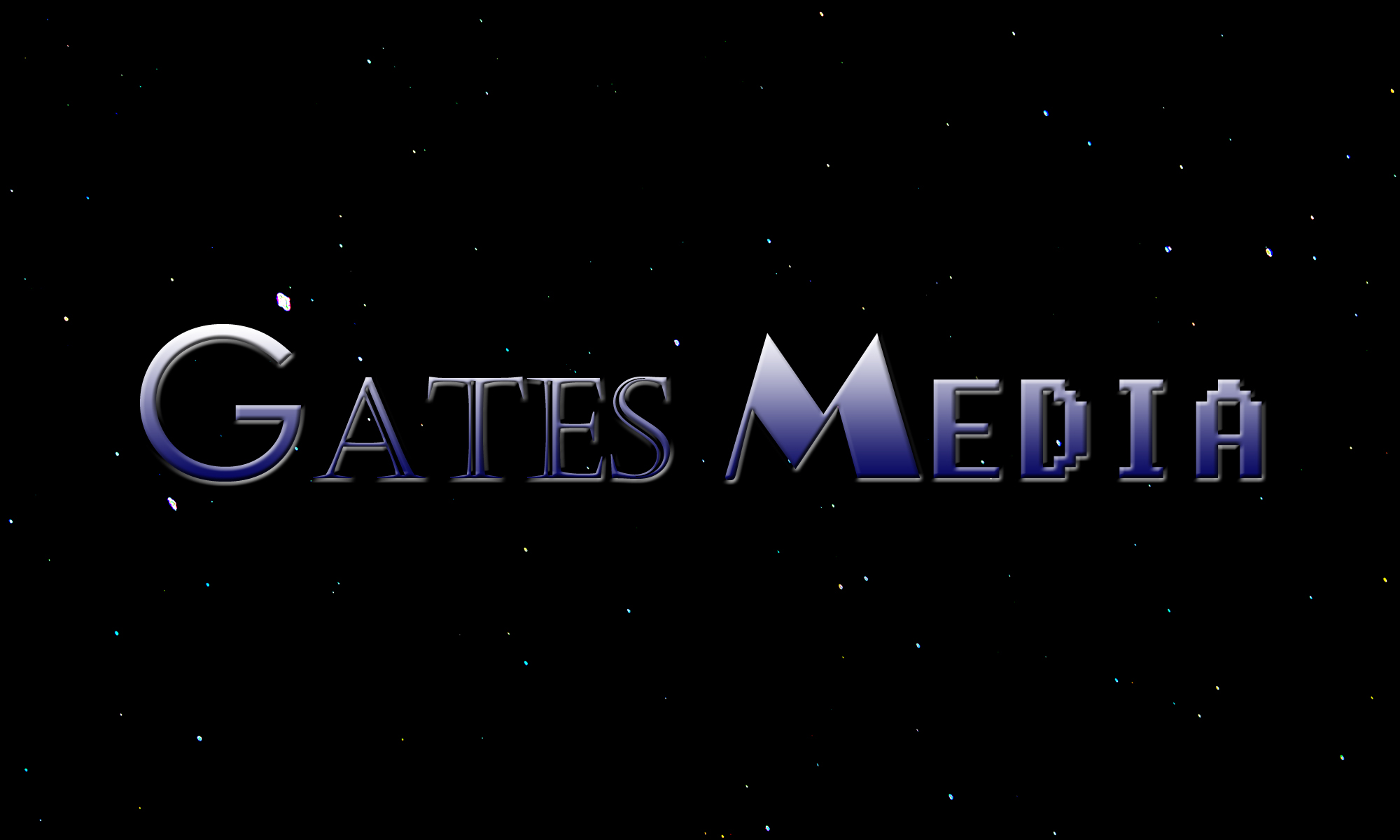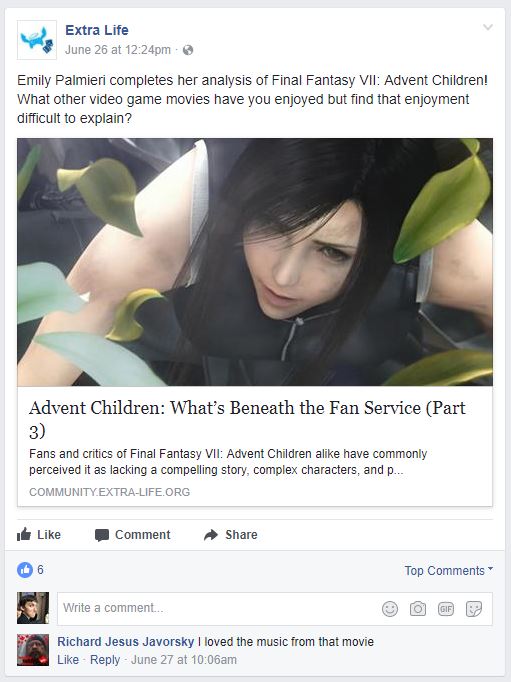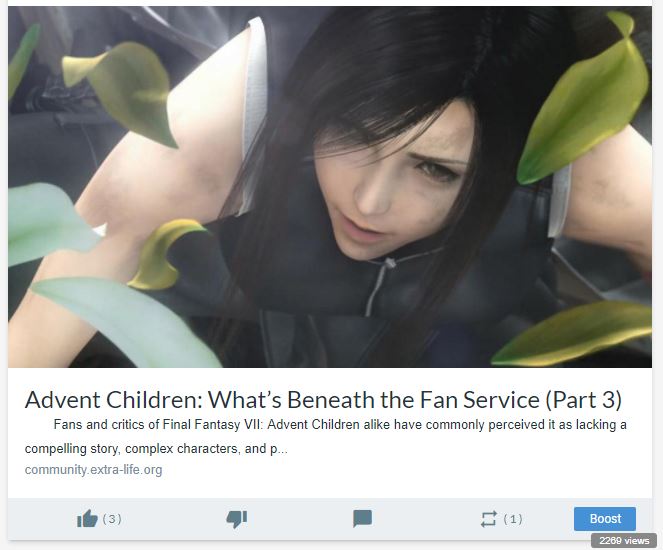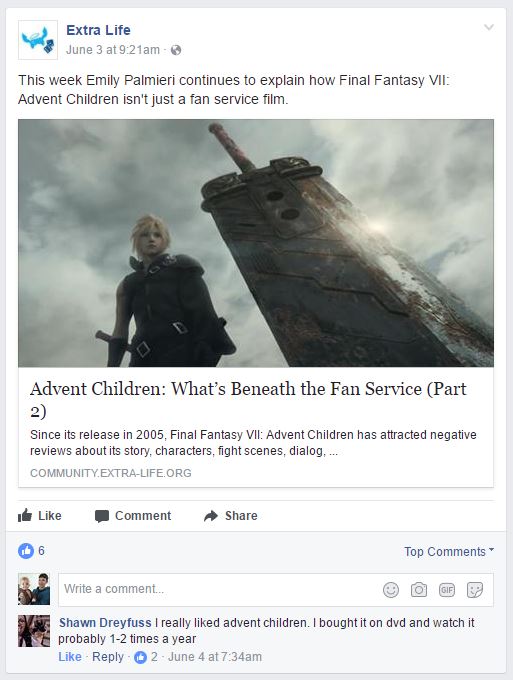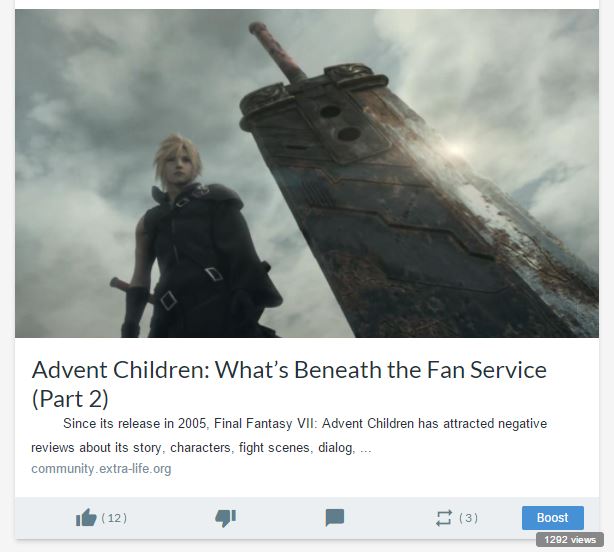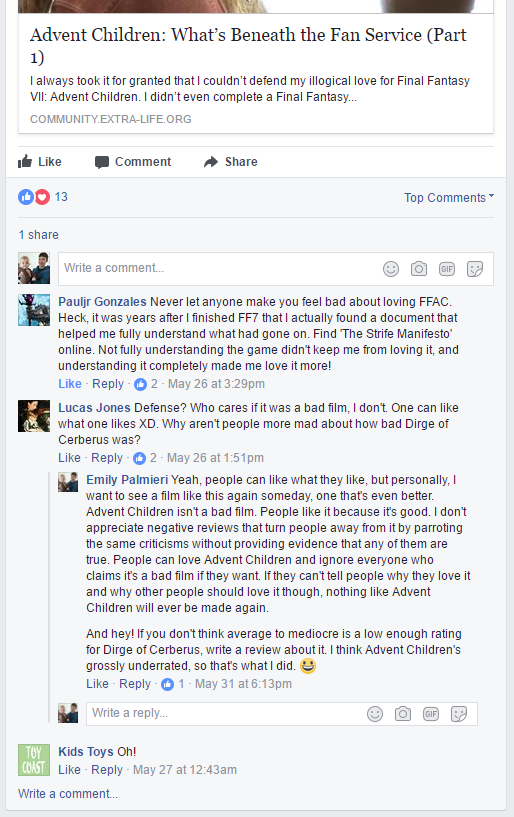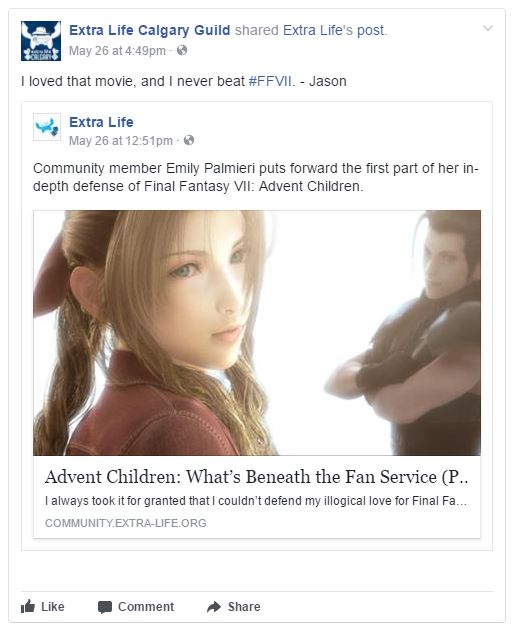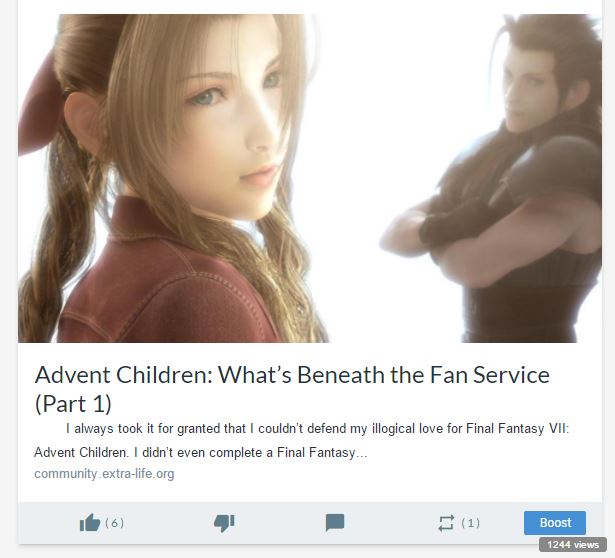Advent Children: What’s Beneath the Fan Service (Part 3)
Hello once again, Final Fantasy VII: Advent Children fans! Have you ever read a review of Advent Children and wondered if the author actually watched the movie? How about listening to reviewers parrot common criticisms about the film only to finish by saying that they love it? How can this film be so amazing and so unique and still receive dominantly negative reviews claiming that it is everything it is not?
Advent Children: What’s Beneath the Fan Service is a three-part series in which I debunk common misconceptions about what is arguably one of the most important CGI movies ever made. Part 1 analyzed Advent Children’s story, characters, and themes. Part 2 discussed how the film tells its story through action. Now, part 3 speculates why Advent Children is so misunderstood and argues its importance in filmmaking history. You can find it here.
Thank you so much for reading. I hope this glimpse beneath the fan service gives you the courage to tell people why you love this movie and why they should love it, too. What does Advent Children mean to you?
I’d like to thank Jack Gardner and Extra Life for supporting this series. For those of you who don’t know, Extra Life is like a marathon for charity, but instead of running or walking, you play video games to raise money for a Children’s Miracle Network Hospital of your choice. The official Extra Life event happens November 4 this year, but you can raise money whenever you want year round. Check out the Extra Life website to learn more, donate, and sign up!
Kingsglaive vs Advent Children: Where Nonsense Originates
Transcript:
Kingsglaive: Final Fantasy XV and Final Fantasy VII: Advent Children get compared a lot. They both contain extravagant action scenes, were created by Square Enix, and are based on games in the Final Fantasy franchise. Both also receive criticism for having convoluted and confusing plots. But how justified is this comparison? In a previous video, I talked about how Kingsglaive’s visuals contradict its audio and its general visual chaos. Is that all that makes its story incoherent? Does Advent Children have the same problem with visual communication? Let’s compare three aspects of their stories to find out.
Both films feature protagonists with inner conflicts that they must confront. Nyx in Kingsglaive deals with the deaths of his mother and sister and his status as an immigrant… supposedly. The film shows the source of Nyx’s torment through a poster board in his room, which has photos of his family and characters likely drawn by his sister. Nyx also watches a cartoon on TV that features the same characters. Nyx, however, looks at these things with indifference… or maybe rage. Is he tormented, or is he just eating something? Stop changing the camera angle every two seconds!
He seems to have a fear that his past will lead to his death. Maybe? What prompted him to think this thought? He’s just sitting on the steps, and then, some guy falls out of the sky and vomits. Nyx hears his sister’s voice throughout the film, but these memories only cause mild inconveniences.
Similarly, guards only occasionally taunt his immigration status. The rest of the time he just plows through them. [“Hey, hey, hey, hey, hey, hey! Wait a minute! Stop!”] Despite the suggestion that he must overcome these problems, we don’t ever know why they’re problematic… except when he decides Princess Luna needs to know about his sister mid-chase scene.
In contrast, Cloud’s inner torment in Advent Children is clearly a problem that he must solve if he expects to survive the film. Cloud deals with the deaths of his friends Zack and Aerith and his affliction with an incurable disease called geostigma. He experiences intrusive visions from his past at inopportune times. He pushes his surviving friends away out of guilt. He feels pain and bleeds blue ink from geostigma. Cloud’s battle against his inner demons makes it difficult for him to fight the enemies resurrected from his past in reality. His inner problems integrate so well with his external struggles that battling his enemies and reuniting with his friends is synonymous with letting go of his past and finding his place in the present.
Kingsglaive and Advent Children also have bad guys that must obtain something important to fulfill their evil plans. In Kingsglaive, the empire Niflheim wants to steal the kingdom of Lucis’ Crystal, which it uses to defend its capital city Insomnia with a magical wall; obtain a magical ring from Lucis’ King Regis; kill and/or kidnap Lucis’ ally Princess Luna; and/or kill King Regis. If that previous semblance of a sentence didn’t clue you in, Kingsglaive doesn’t explain why Niflheim or Lucis care about any of these goals. Let’s look specifically at the Crystal, which at first glance appears to be the most powerful object in the movie. The Crystal is so important in fact that it’s the first thing that we see in the film.
Unfortunately, the scenes during which Niflheim steals it are so chaotic that they render its importance questionable at best. During a distraction peace treaty, Niflheim’s troops enter a smoky room outside the Crystal’s hold. [“The Crystal! They’re after the Crystal!”] The troops break into a room with a control board and a vault door leading to the Crystal. They blow up the control panel, which causes Insomnia’s wall to fall. [“The wall, it’s gone.”] Later, Niflheim’s chancellor and emperor watch one of their ships carry the Crystal away.
It sounds straightforward… until you mix it with King Regis’ battle against robots and a menacing suit of armor and Nyx’s fight with traitorous teammates and a giant octopus. Additionally, the Crystal doesn’t look like a crystal, and this movie doesn’t like to hold any of its shaky and poorly chosen shots for more than two seconds. There’s a reason why the characters narrate this entire heist. “They broke into a room with a… panel? Where’s the Crystal?” “What is this black thing covered in smoke?” [“The Crystal!”] “Oh, you mean this window divider is the Crystal?”
The aftermath doesn’t stress the importance of this event either. No one cares. Nyx and Luna point out that the wall has fallen before they return to killing traitors. The ambassador and the emperor of Niflheim talk about what happens next. “The Crystal…! Well, let’s go see if King Regis is still alive.” With the editing and cinematography, stealing the Crystal has as much weight as saving Luna from octopods and King Regis fighting for his life. In the end, do any of them matter? The Crystal’s gone. Regis dies. Luna throws herself out of an airship and yet is entrusted with a magic ring that no one can wear.
Advent Children’s antagonist Kadaj wishes to find the remnants of Jenova, an alien being that caused a catastrophe long ago. When Kadaj discovers the alien matter hidden in plain view, the film highlights its importance by making an event out of it. The possessor, Rufus, and Kadaj attract the attention of almost every major member of the cast when Rufus tosses Jenova’s remains off a building, and he and Kadaj jump after them in slow motion. Kadaj tries to grab the box out of the air while Rufus shoots at it.
This scene occurs between two fight scenes, but they all feel very different, which makes it stand out. This scene features a desperate few seconds dragged out into almost a minute. The previous scene shows Cloud rediscovering friendship power, and the next has a high-speed motorcycle battle. While we don’t know until the end of the movie what Kadaj will do with Jenova, the dramatic visuals in this scene foreshadow the importance of him obtaining it.
Finally, the protagonists in both films must follow the clues to reach their goals and solve problems. Nyx tends to just know things for no reason. [“Your hairpin. They’re tracking it. Give it to me.”] [“Pelna, get out of there! It’s a trap!”] At one point, Nyx discovers a pattern on an enemy monster and somehow makes the connection that it’s attracted to a hairpin that Luna wears despite neither of them bearing any resemblance to one another. Similarly, he somehow determines that a trap octopus monster is onboard an airship in response to his teammate observing enemy guards. These are relatively minor problems in comparison to Nyx’s unexplained faith that a suicidal woman, a ring that kills everyone who wears it, and an absent prince have more importance to the future that he wants to save than an entire city of people who might have lived in it.
In contrast, the characters in Advent Children know surprisingly little about anything. [“So what’s going to happen now?”] [“Where’s Mother?”] [“Kadaj, what is he?”] [“Who’s that?”] [“What’s this stuff about Mother?”] [“What do you mean?”] Cloud seems clueless as to how Kadaj will reincarnate Sephiroth right up until Kadaj shoves Jenova cells in his chest. He doesn’t know the cure for geostigma until he’s cured. He doesn’t even seem know what happens at the end of the movie. [“It’s like she said: ‘Wait here and Cloud will come back.'” …] The film provides visual clues for the audience to interpret what happened, but the characters don’t usually do this themselves, at least not audibly.
This final point sums up what Advent Children and Kingsglaive do that makes their stories confusing to follow. They depict two visual storytelling extremes. Advent Children shows all its clues but rarely interprets what they mean audibly while Kingsglaive states what difficult to decipher and non-existent visual clues mean even when that interpretation doesn’t make sense. I’ll let you decide if a blank stare is a preferable explanation to: [“Your hairpin. They’re tracking it. Give it to me.”]
So how do their fight scenes compare? That’s a subject for another video. Talk at you next time.
[“A man’s past is his pride.” “No, my pride is shaping the future.”]
Advent Children: What’s Beneath the Fan Service (Part 2) Response
Advent Children: What’s Beneath the Fan Service (Part 1) Response
Advent Children: What’s Beneath the Fan Service (Part 1)
You can find The Strife Manifesto here. It’s an interesting analysis of Cloud’s character in the game.
Advent Children: What’s Beneath the Fan Service (Part 2)
Hello again, Final Fantasy VII: Advent Children fans! Have you ever wondered what makes Advent Children’s high-speed motorcycle battles, giant swords, and physics-defying action awesome? What does this movie do that other action movies don’t? Would you believe that Loz throwing a motorcycle with his feet, friendship defeating Bahamut, and a gunshot wound threatening to kill Cloud all follow a consistent set of rules?
Advent Children: What’s Beneath the Fan Service is a three-part series in which I debunk common misconceptions about what is arguably one of the most important CGI movies ever made. Part 2, now up on the Extra Life Community website, discusses how Advent Children tells its story and defines its world through action, visual language, and efficient dialog. You can find it here. If you missed part 1, which analyzes the story Advent Children tells, you can read that here.
Feel free to spread this around! If you want more movies like Advent Children, don’t be afraid to tell people why you love it and why they should love it, too. Everyone needs to know what’s beneath the fan service.
For those of you who don’t know, Extra Life is like a marathon for charity, but instead of running or walking, you play video games to raise money for a Children’s Miracle Network Hospital of your choice. The official Extra Life event happens November 4 this year, but you can raise money whenever you want year round. Check out the Extra Life website to learn more, donate, and sign up!
Advent Children: What’s Beneath the Fan Service (Part 1)
Hey, Final Fantasy VII: Advent Children fans! Have you ever wondered if Advent Children is more than fan service? Do you question why you like a film known for its poor story, weak characters, and unrealistic action scenes? Would it surprise you to know that criticisms of Advent Children have little to no basis in reality?
Advent Children: What’s Beneath the Fan Service is a three-part series in which I debunk common misconceptions about what is arguably one of the most important CGI movies ever made. Part 1, now up on the Extra Life Community website, analyzes Advent Children’s story, characters, and themes under a lens that has little to do with the game it’s based on. You can find it here.
Feel free to spread this around! Fans and haters alike need to know what’s beneath the fan service.
For those of you who don’t know, Extra Life is like a marathon for charity, but instead of running or walking, you play video games to raise money for a children’s hospital of your choice. The official Extra Life event is on November 4 this year, but you can raise money whenever you want year round. Check out the Extra Life website to learn more, donate, and sign up!
Speech Therapy: Season 2 Bloopers and Extras
The second season of Speech Therapy has lasted for more than two years, so I’m arbitrarily ending it. I hope to make new episodes more regularly. Hey! This is the third episode I’ve released in the past five months! Regular releases could become a thing… maybe.
Speech Therapy: The Spider Robot Dilemma
Transcript:
Appleseed Alpha entertained me, and I don’t say that often about the subset of CGI movies that I review. It looks beautiful and contains great action, characters who interact with one another like people, characters with fun personalities, interesting designs, awesome music, and of course, unintentionally ridiculous moments. [“The death… They could’ve taken her anywhere! It’s pointless!”] By the end of the movie, when it obviously set up potential for a sequel, I found myself thinking, “You know… I wouldn’t mind that.”
This movie’s great… as long as you don’t think about anything that happens in it. So just for fun, let’s think about what happens in it.
The story follows former soldiers and couple Deunan and Briareos. After World War III’s end, the protagonists find themselves in the service of crime boss and overlord of New York Two Horns. The war left Briareos, a cyborg, weak and in need of frequent recharges, which Two Horns provides in exchange for Deunan’s and Briareos’ services. Despite their wish to leave the ruined city, Two Horns and Briareos’ weakness won’t allow it.
This changes when the protagonists meet Olson and Iris, who have a mission to destroy a powerful weapon left over from the war. Deunan and Briareos save Olson and Iris from automated war-time robots. As payment, Olson finds a defective chip in Briareos that causes his weakness and removes it. Apparently, Briareos’ mechanic implanted it in him on Two Horn’s orders. With his strength restored, Briareos and Deunan decide to accompany Olson and Iris on their mission.
The antagonist, a cyborg named Talos has different plans for the weapon though. Originally given a mission to dispose of left over weapons from the war, Talos decides it would be more effective to control a weapon capable of enforcing the peace and controlling the world, the same weapon that Iris must destroy. Talos kidnaps Iris and kills Olson in order to learn the location of the weapon and control it. Iris is a bioroid, an artificial human, created specifically to destroy the weapon. As such, she has the ability to activate the weapon through its iris scanner.
Talos forces Iris to bring the weapon to life, but not everything goes as planned. Shortly after powering on, the weapon begins an automated sequence to self-destruct in the middle of the New York. Deunan and Briareos catch up to them after discovering Olson’s body and information on where to find the weapon. Deunan and Iris kill Talos and come up with a plan to destroy the weapon with Briareos. Seconds from success though, Iris reveals that she must sacrifice herself in order to keep the weapon’s shields down and give Briareos a shot at destroying its power generator with a sniper rifle.
First of all, why does this weapon have an automated sequence to destroy New York? Iris explains that it’s a weapon programmed for retribution in the event that the country fell to its enemies. Who is this weapon punishing though? The country? “You lost! Loser! That’s what you get!” New Yorkers? Clearly, if we lose World War III, it’s New York’s fault. “Damn liberals ruined the country!”
Okay, maybe this weapon is punishing America’s enemies by destroying its crown city… New York. Yeah, how’s that feel Los Angeles? Who cares about you, Washington, DC? “You’ll never take our country’s greatest source of pizza alive!” It’s an ingenious idea, placing a booby-trapped weapon on your own soil. When the enemy discovers it in their new country after the war ends, they’ll unwittingly destroy New York. “Fools! Now we have the last laugh!” I’m sure everyone who lives there currently would willingly die for this trickery.
Second, what causes the weapon’s automated self-destruct sequence to begin in the movie? When Talos discovers that he doesn’t have control of the weapon, we hear the computer stating [“Hull breach verified. Self-defense system protocol initiated.” “No!”]. So when this weapon’s hull is breached, it automatically begins an uninterruptable process to destroy New York. [“What?”] I guess if this weapon’s primary function is retribution, it’d better make sure that it carries it out. You had one job, weapon!
Exactly how much damage classifies a hull breach? Before this automated sequence begins, Deunan shoots at a cargo door, so apparently, not very much. A bird could probably fly into a window and begin the automated self-destruct sequence. The weapon was never completed though, which could have caused the computer to identify missing pieces of the hull as a hull breach. This suggests, however, that the people building this robot would destroy New York if they so much as turned it on. The designers must have just really hated New York.
Third, why does Iris have to die? Iris explains to Deunan that she must stay on the weapon to keep its shields down presumably by holding a button or something. So an operator can’t disable the weapon’s self-destruct sequence, but they can disable its shields. It’s a safety feature. In the event that you accidentally sentence New York to destruction, you can disable the weapon’s shields by holding down a button and hope that other people can destroy it in time.
Fourth, why does it have to be a spider robot? This weapon’s primary function appears to be to blow up New York. Why not just bury a bomb in the middle of New York and blow it up when the country loses the war? Why build a giant war machine for the sole purpose of walking a few miles to New York? You could probably put bombs beneath every major city in America for a fraction of the cost of building a massive spider robot that only blows up one. Sure, the robot in the film was incomplete, and if it weren’t, maybe Talos could rampage around the country with it for a while. But the end point is still, for no apparent reason, New York.
Finally… why is Deunan so upset about this? When Deunan and Briareos discover Olson’s dead body, Deunan briefly throws a fit. [“We finish what he started.” “I don’t think I can.” “What?” “It’s too much… The death… They could’ve taken her anywhere! It’s pointless!”] Um… Is death new? Deunan is a former soldier. She murders a number of people in the movie and watches Briareos do the same. She doesn’t have nearly this reaction when Iris dies. She’s angry and hurt, but she doesn’t lay down her weapon and call everything pointless. She didn’t give any indication of giving up when she and Briareos were trapped in the city or fighting enemies in the weapon bunker or chasing after the spider robot. Briareos doesn’t care this much, and he’s been through as much as she has. This level of despair seems out of character for a kind but otherwise tough and stubborn soldier.
So overall, Appleseed Alpha is a fun movie about a girl who has to kill herself to stop a giant spider fortress built only to blow up from destroying an already ruined city. Also, Deunan is a woman. She has feelings. I wonder what the sequel will be like.
Talk at you next time.
[“You’re too late. She’s already dead.” “No, but you are.”]
Sausage Party’s on Netflix!
Know what else is on Netflix? Sausage Party. I’m disgusted but not as disgusted as I expected to be by it. The references to other CGI movies such as Toy Story, Antz, and, of course, Foodfight! were neat, and the movie tried to say something. I’m still trying to determine whether what it said was profound, disgusting, or generic though. When my disgust wears off, perhaps I’ll watch it again.
